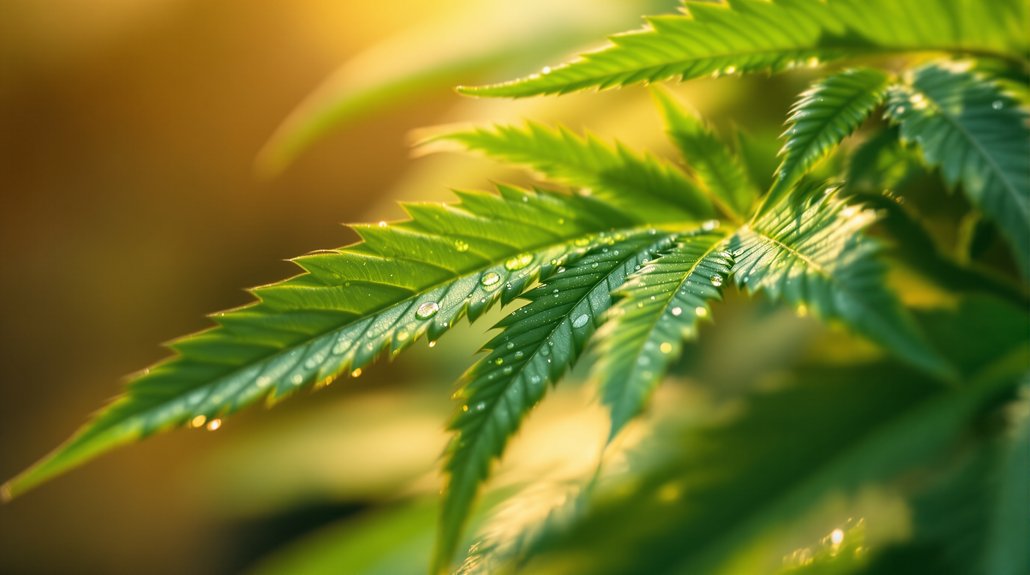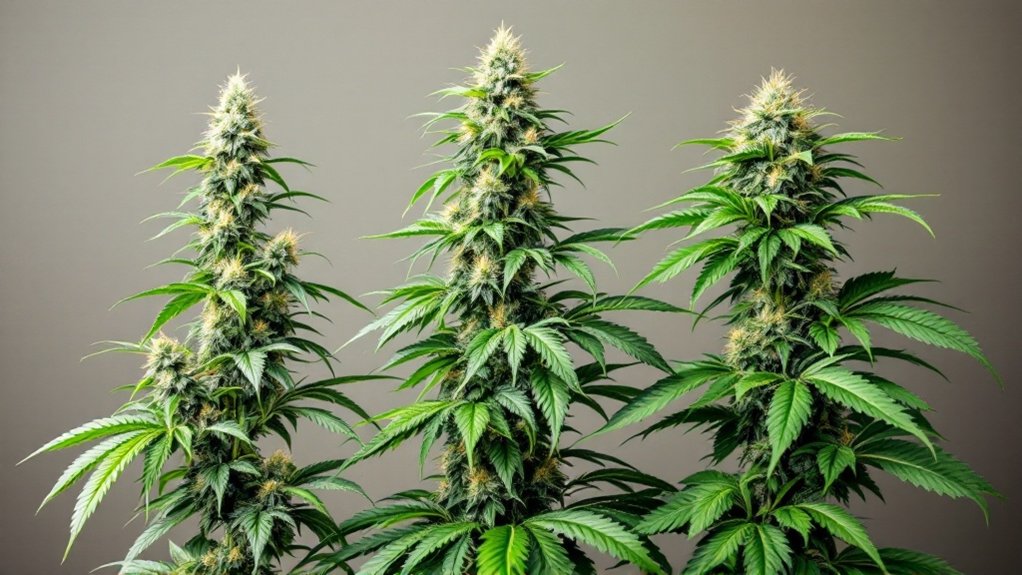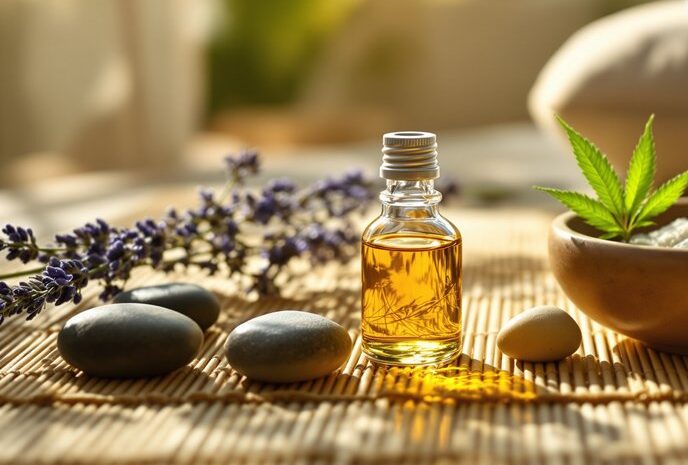Cannabis users are increasingly viewing their consumption through a wellness lens rather than purely recreational terms. Medical professionals report growing patient interest in cannabinoid-based self-care routines for managing chronic conditions, sleep disorders, and stress-related symptoms. The shift represents a fundamental change in how society approaches plant-based therapeutics. Research institutions continue documenting measurable benefits across pain management, anxiety reduction, and sleep quality improvement. This emerging wellness paradigm raises important questions about ideal integration methods and long-term health outcomes that demand closer examination.
Understanding Cannabis as a Therapeutic Wellness Tool

The human body operates its own sophisticated cannabis-like system, a biological network that scientists only discovered in the 1990s despite its fundamental role in daily health.
The endocannabinoid system regulates mood, appetite, sleep, and pain through specialized CB1 and CB2 receptors scattered throughout the brain and immune system.
Cannabis compounds like CBD and THC work by modulating this existing biological framework.
Research demonstrates CBD’s effectiveness in managing anxiety disorders, reducing insomnia, and calming stress responses. The anti-inflammatory properties prove particularly valuable for conditions like arthritis and inflammatory bowel disease. CBD reduces inflammation by stimulating anti-inflammatory cytokines while simultaneously diminishing harmful pro-inflammatory responses.
This discovery explains cannabis’s diverse therapeutic effects across multiple body systems.
From seizure management in epilepsy patients to supporting addiction recovery, cannabinoids fundamentally fine-tune the body’s natural regulatory mechanisms rather than introducing foreign substances. Medical cannabis patients frequently report a 64% reduction in their reliance on traditional opioid medications for pain management. Unlike THC, THCA offers neuroprotective benefits without producing intoxicating effects until heated through the decarboxylation process.
Pain Relief and Physical Comfort Through Cannabis
Millions of chronic pain sufferers have discovered what researchers are now validating through rigorous scientific study: cannabis compounds can interrupt pain signals at their source.
Yale researchers found that cannabigerol (CBG) demonstrates the strongest inhibition of Nav1.8 protein, the central player in pain signaling pathways. This non-psychoactive compound offers relief without the mental fog.
Terpenes pack their own punch. University of Arizona studies reveal these aromatic compounds relieve chronic neuropathic pain nearly as effectively as morphine, minus the addiction risk. When combined with morphine, terpenes enhanced pain relief significantly beyond what either treatment achieved alone.
The average therapeutic dose hovers around 19.82 mg daily, though neuropathic pain typically requires higher amounts at 23.56 mg. These findings offer hope for managing conditions like neuropathic pain and arthritis through cannabinoid mechanisms.
Over half of chronic pain patients report decreased prescription opioid use after incorporating cannabis. That’s fewer side effects and reduced dependency concerns.
Mental Health Benefits and Emotional Balance

While physical pain captures headlines in cannabis research, mental health applications are quietly building an equally compelling evidence base. Clinical trials demonstrate CBD’s anxiety-reducing properties across multiple disorders without considerable side effects. Australian research organizations are launching large-scale studies to confirm these promising results.
The emotional regulation benefits extend beyond simple stress relief. Medical cannabis patients report improved mood balance, with some reducing their reliance on conventional antidepressants and mood stabilizers. Research indicates that heavy cannabis users report higher rates of suicidal thoughts than nonusers, highlighting the importance of careful monitoring and dosage considerations. For those seeking non-psychoactive options, raw cannabis containing THCA offers potential therapeutic benefits without the intoxicating effects of THC.
CBD shows particular promise in schizophrenia trials, reducing hallucinations and delusions when used alongside traditional antipsychotic medications. Many patients experiencing treatment-resistant mental health conditions are exploring cannabinoids when first-line clinical approaches prove insufficient.
However, dosage matters considerably. Low-dose THC may decreases anxiety, while higher concentrations can trigger the opposite effect. This delicate balance explains why personalized approaches are becoming standard practice in mental health cannabis applications.
Enhancing Physical Function and Daily Energy
Beyond mental wellness applications, cannabis research reveals surprising insights about physical performance and daily energy management. Studies show cannabis exhibits bronchodilator properties, increasing forceful expiration capacity while demonstrating minimal impact on maximal exercise performance.
The real game-changer lies in pain management applications. CBD reduces inflammation-causing fibroblasts in rheumatoid arthritis, encouraging greater movement participation. Cannabis users with chronic pain conditions report notably increased ability to engage in physical activity compared to non-users. This isn’t just perception, reduced joint pain and inflammation directly supports improved functional movement.
Cannabinoid therapy may reduce fatigue perception through diminished pain and inflammation, indirectly boosting daily energy levels. Heavy chronic smoking shows decreased exercise capacity, but moderate use demonstrates different outcomes. Various consumption methods including inhalation, edibles, and vaporization offer different onset times and effects for tailored wellness approaches.
Tolerance develops to acute cardiovascular effects with regular use, potentially stabilizing overall daily function. Research indicates that chronic cannabis use does not significantly impact physical performance in recreationally active individuals. In Texas, patients with certain conditions can access medical cannabis with up to 1% THC content through the state’s Compassionate Use Program.
Improving Sleep Quality and Appetite Regulation

Two fundamental pillars of wellness, sleep and appetite respond predictably to cannabis intervention, though the relationship proves more nuanced than simple cause-and-effect.
Medical cannabis users with insomnia show measurable long-term sleep quality improvements over 90 days, with the endocannabinoid system directly regulating sleep cycles. Higher CBD concentrations enhance sleep efficiency and duration, particularly benefiting older adults. Cannabinol (CBN), known as the sleepy cannabinoid, promotes relaxation and eases tension when taken 2-3 hours before bedtime.
However, daily use creates a paradox, frequent edible consumers often experience worse sleep quality despite expecting improvement. Research reveals that moderate cannabis users average just over five days of use in a two-week period, suggesting intermittent rather than continuous consumption patterns.
Cannabis reliably stimulates appetite through CB1 receptor activation, making THC effective for treating cachexia and appetite loss in chronic illnesses. The infamous “munchies” effect enhances food palatability across all administration methods.
Real-world studies demonstrate that increased use frequency correlates with sleep improvements but raises concerns about potential cannabis use disorder development. Success depends critically on dose, cannabinoid ratios, and individual factors. The sweet spot remains elusive.
Social Connection and Role Performance Enhancement
Cannabis extends its influence far beyond the bedroom and kitchen table, reshaping how users navigate social landscapes and perform in various life roles. Research reveals that regular users demonstrate higher empathy levels on psychological assessments, with brain imaging showing enhanced connectivity in the anterior cingulate, the brain’s empathy headquarters.
This neurological shift translates into tangible behavioral changes: prosocial behavior scores jump considerably among recent users compared to nonusers. The substance functions as a social lubricant, reducing anxiety that typically hampers group interactions. Male users show observable increases in agreeableness, while workplace communication and collaboration abilities reportedly improve. These findings suggest therapeutic applications for conditions like social anxiety and avoidant personality disorder.
However, these benefits remain transient and context-dependent. Some individuals experience social withdrawal instead of connection. The effects hinge on individual factors, dosage, and setting, making cannabis‘s social impact a personalized equation rather than universal solution. Studies show users exhibit enhanced moral decision-making capabilities, particularly in areas concerning fairness and preventing harm to others.
Many find cannabis-focused social gatherings create a sense of inclusive community where diverse groups can connect through shared rituals and experiences.
Choosing the Right Cannabis Products for Your Needs
The dispensary aisle presents a bewildering array of options that can overwhelm even seasoned users seeking targeted relief. THC and CBD ratios drive primary effects, with high-THC products delivering euphoric experiences while CBD-dominant varieties reduce anxiety without intoxication.
Product forms cater to different lifestyles and needs. Flower remains king, capturing 20% of cannabis sales through familiar smoking methods. Concentrates pack potent doses for experienced users requiring rapid relief. Vape cartridges offer discrete consumption with fast onset times.
Edibles provide long-lasting effects but demand patience, as onset can take two hours. Tinctures deliver controlled dosing through sublingual drops, appealing to medical users. Ingested cannabis converts to 11-hydroxy-THC, producing more intense effects than smoking or vaping.
Strain selection matters beyond trendy names. Sativas energize daytime routines while indicas promote nighttime relaxation. Indica strains have been shown to help 72% of users manage chronic pain effectively. Hybrids blend both worlds for targeted outcomes. Topical cannabis products like creams and salves provide localized relief without entering the bloodstream.
Long-Term Considerations and Sustainable Practice
While selecting appropriate products marks just the beginning of a cannabis wellness journey, understanding long-term health implications becomes paramount for users integrating these substances into their daily routines.
Research reveals chronic use carries significant risks including cardiovascular complications, respiratory issues, and cognitive impairments. Heavy users face an average IQ decrease of 5.5 points from childhood to midlife. Daily consumption links to persistent cough, bronchitis, and increased heart disease risk. Heavy cannabis use can also trigger Cannabinoid Hyperemesis Syndrome, causing uncontrollable vomiting that requires complete cessation to resolve.
Long-term cannabis use poses measurable risks to cardiovascular health, respiratory function, and cognitive performance that users must carefully consider.
Sustainable practice demands strategic approach. Periodic tolerance breaks allow neuroadaptive changes to potentially reverse. Non-smoking methods like edibles and tinctures reduce respiratory damage considerably. Those seeking high-potency options should be aware that cannabis concentrates like shatter can contain up to 95% THC, requiring extremely careful dosing. Long-term users showed smaller hippocampi, brain regions crucial for learning and memory function.
Regular health monitoring becomes essential for cardiovascular and cognitive function assessment. Age of onset matters tremendously, earlier use amplifies long-term consequences. Frequency and dosage tracking helps minimize adverse effects while maintaining therapeutic benefits.
Looking for more on cannabis culture? Check out our article series here.









